

Advanced Process Control Engineer: Job Description and Requirements. Making an industrial production process as efficient and standardized as possible is the goal of an advanced process control engineer.
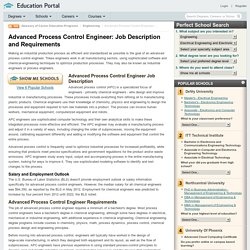
These engineers work in all manufacturing sectors, using sophisticated software and chemical-engineering techniques to optimize production processes. They may also be known as industrial engineers or process engineers. Advanced Process Control Engineer Job Description Advanced process control (APC) is a specialized focus of engineers - primarily chemical engineers - who design and improve industrial or manufacturing processes.
These processes include everything from refining oil to manufacturing plastic products. APC engineers use sophisticated computer technology and their own analytical skills to make these integrated processes more effective and efficient. Salary and Employment Outlook The U.S. On-line analyser, analyzers, slurry measurement, slurry analyser. Proven Methods and Best Practices for Practical Process Control by ControlGuru. Control Systems/MIMO Systems. Multi-Input, Multi-Output[edit] Systems with more than one input and/or more than one output are known as Multi-Input Multi-Output systems, or they are frequently known by the abbreviation MIMO.
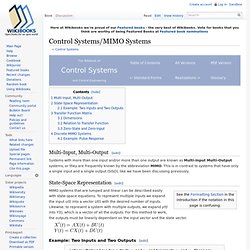
This is in contrast to systems that have only a single input and a single output (SISO), like we have been discussing previously. State-Space Representation[edit] See the Formatting Section in the introduction if the notation in this page is confusing. MIMO systems that are lumped and linear can be described easily with state-space equations. Example: Two Inputs and Two Outputs[edit] Let's say that we have two outputs, y1 and y2, and two inputs, u1 and u2.
Advanced process control. In control theory Advanced process control (APC) refers to a broad range of techniques and technologies implemented within industrial process control systems.
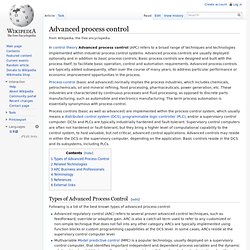
Advanced process controls are usually deployed optionally and in addition to basic process controls. Basic process controls are designed and built with the process itself, to facilitate basic operation, control and automation requirements. Advanced process controls are typically added subsequently, often over the course of many years, to address particular performance or economic improvement opportunities in the process.
Process control (basic and advanced) normally implies the process industries, which includes chemicals, petrochemicals, oil and mineral refining, food processing, pharmaceuticals, power generation, etc. These industries are characterized by continuous processes and fluid processing, as opposed to discrete parts manufacturing, such as automobile and electronics manufacturing. Dynamic Shrink/Swell and Boiler Level Control - Practical Process Control by Control Guru. Smith predictor. Suppose the plant consists of followed by a pure time delay As a first step, suppose we only consider (the plant without a delay) and design a controller with a closed-loop transfer function that we consider satisfactory.
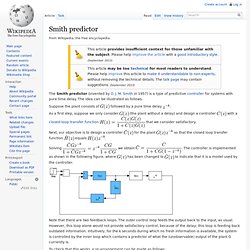
Next, our objective is to design a controller for the plant so that the closed loop transfer function equals Solving , we obtain . Has been changed to to indicate that it is a model used by the controller. Note that there are two feedback loops. To check that this works, a re-arrangement can be made as follows: Here we can see that if the model used in the controller, , matches the plant perfectly, then the outer and middle feedback loops cancel each other, and the controller generates the "correct" control action. References[edit] K. Closed-loop transfer function. Overview[edit] The closed-loop transfer function is measured at the output.
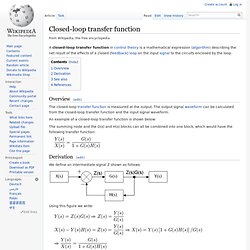
The output signal waveform can be calculated from the closed-loop transfer function and the input signal waveform. An example of a closed-loop transfer function is shown below: The summing node and the G(s) and H(s) blocks can all be combined into one block, which would have the following transfer function: OPC Tunnelling. Advanced OPC Tunnelling Enabling network access to real-time data (avoiding DCOM problems) The OPC DataHub enables you to 'tunnel' data across a network, thanks to its secure, robust peer-to-peer connection model that completely avoids the DCOM and Windows security problems usually encountered when trying to network OPC data.
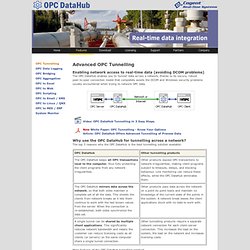
Why use the OPC DataHub for tunnelling across a network? The top 3 reasons why the OPC DataHub is the best tunnelling solution available: More features of the OPC DataHub tunnelling product. A simple 3 step procedure gets you up and running in minutes. Distributed Component Object Model. Distributed Component Object Model (DCOM) is a proprietary Microsoft technology for communication among software components distributed across networked computers.
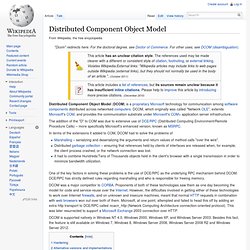
DCOM, which originally was called "Network OLE", extends Microsoft's COM, and provides the communication substrate under Microsoft's COM+ application server infrastructure. The addition of the "D" to COM was due to extensive use of DCE/RPC (Distributed Computing Environment/Remote Procedure Calls) – more specifically Microsoft's enhanced version, known as MSRPC. In terms of the extensions it added to COM, DCOM had to solve the problems of One of the key factors in solving these problems is the use of DCE/RPC as the underlying RPC mechanism behind DCOM. DCE/RPC has strictly defined rules regarding marshalling and who is responsible for freeing memory. DCOM is supported natively in Windows NT 4.0, Windows 2000, Windows XP, and Windows Server 2003.